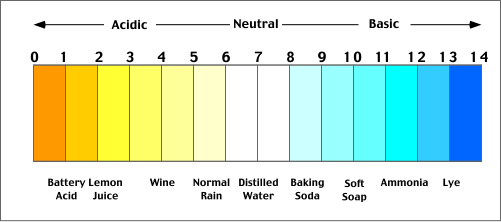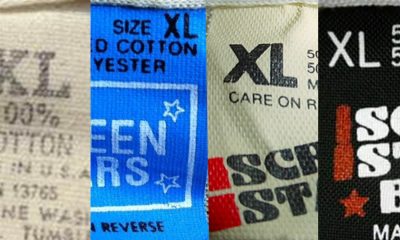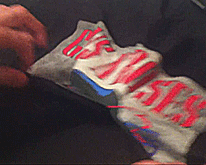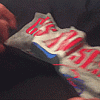Demonstration
Dry Rot: Can You un-pHuck Your T-Shirt?
What is Dry Rot?
Surely you’ve done it. It’s mail day, and there’s a package with your name on it. You tear open the mailer and inside is that deadstock t-shirt you ordered last week. As you slip your arms through the holes and pull it over your head, you hear that unmistakable sound of fabric ripping. You’re not Hulk Hogan (hell, you’re not even Brooke Hogan), but somehow you’ve summoned the super-human strength to rip through a t-shirt like it’s Wrestlemania 3? It might be all of the steroids they’re putting in our chicken these days, but more than likely something just wasn’t right about that tee.
“It was deadstock though, it should be perfect, right?” Nope. That’s actually one of the key factors in this t-shirt phenomenon called Dry Rot that weakens the fabric to the durability of wet paper. The other factors WERE that the shirt had to be black, 100% cotton, and from the early to mid-1990s also. (Dry rot will still affect a 50/50 poly/cotton blend, though it just deteriorates the cotton portion and leaves behind a paper-thin, see-through, poly shirt.)
Notice how I said “were?” That’s because it’s about to get worse.
Last month on a trip to New York for a deadstock lot, we picked up about a thousand band and concert t-shirts ranging from 1994-2002. We checked for dry rot on a few of the high-risk tees by giving the fabric a little stretch and everything checked out fine. Affected t-shirts won’t stretch when pulled, the fabric will just split. By chance, one of the shirts that were far out of the early 90s danger zone was given a little tug and unexpectedly, it ripped. Whatever this mystery cancer is that plagues the deadstock shirts from the 90s is back. Now shirts from as late as 2002 have it. We tested every 100% cotton black shirt in the lot and found over 130 that were infected with dry rot. We even found that we had multiples of the same shirt in which some had dry rot and others didn’t. While this was a heartbreaker that Nicholas Sparks couldn’t even write, we knew that we were sitting on a goldmine of information in fabric samples.
After a number of phone calls and dead-end referrals, we finally made a connection with someone from the Cotton Inc headquarters (you know, “The fabric of our lives” people?) Backed with decades of textile knowledge paired with access to labs and chemists, he requested we send in some samples for testing. Among other samples, we sent them 2 identical shirts from the same batch, but only 1 was infected with dry rot. A couple of weeks later we got our answer to the mystery that had been eating our precious black deadstock t-shirts.
Disclaimer: I’m not a rocket surgeon and only partially understand this explanation. Mostly I’m just repeating things. So after the kind folks at Cotton Inc did some science stuff on the fabrics, this is what they found. The culprit behind this fabric deteriorating disease is Sulfur.
What Causes Dry Rot?
Turns out that Sulfur based dyes are often used when the price of fiber reactive dyes are too expensive. Black sulfur dyes are the hardest to oxidize, a process done after the dyeing. If not washed, over time the sulfur becomes insoluble and the fabric becomes acidic. Over the course of years, the acid slowly deteriorates the cotton to the point of dry rot. (So this problem should actually be called “Acid Rot”) While fabric that has already reached this point can not be saved, there is some good news.


How Can You Test For Dry Rot?
We know that shirts don’t start to rip until they have reached a pH balance in the 4s, about the same acidity as a glass of orange juice. The lower the pH number, the more acidic (water has a pH balance of 7). By letting part of a deadstock shirt soak in water, we can actually test the acidity of the water and know if a shirt is vulnerable to dry rot and how close it is. A shirt that reads a pH balance of 4 or 5 will have partial fabric deterioration, but will not be at the easily ripped point yet. Washing the shirt at this phase will neutralize the fabric and halt the deterioration, thus saving it from future dry rot. Unfortunately, I don’t believe you can t save a tee once it’s gone past the point of no return. But feel free to try to prove me wrong.
But how do you measure the pH in the water? $10 gets you one of these pH detectors.
So there it is. After years of scratching heads and drying tears, we finally have an answer to what causes dry rot. It couldn’t have come at a better time either, because we’re about to start seeing a lot more of it. We now know that the use of Sulfur based black dyes was used all of the way into the early 2000s, and is likely still being used today. The key to preventing dry rot lies in early detection.
Check out my recent appearance on the Virtual Flea with 1980 Something Co where we did a deep dive into “dry rot.” There’s also a demonstration on how to test for it so you can save some tees! And visit Wax & Threads for 100% dry rot free t-shirts.


10 Comments
Leave a Reply
This site uses Akismet to reduce spam. Learn how your comment data is processed.












![[ LINK IN BIO ] In honor of May the 4th we connected with a gentleman named Shawn whose father, Ira, worked for ILM. He designed the Biker Scout, need we say more? Shawn shared an epic tale of a bootleg Star Wars tee his dad heroically stashed away despite George Lucas' attempt to have it destroyed.
.
RIP Ira Keeler. Long live the resistance.
.
#vintagetshirt #vintagetee #vintagetees #vintagetshirts #maythe4th #maytheforth #starwarsday #georgelucas #starwarscollectibles #starwarscollectible #ILM #starwarscollection #starwarscollector #starwarscollectors #starwars #starwarsfan
#irakeeler](https://www.defunkd.com/newblog/wp-content/plugins/instagram-feed/img/placeholder.png)

Sam
September 17, 2015 at 2:39 pm
What about 50/50 or 100cotton t-shirts from the 60s-80s? Do we have to worry about dry rot?
thecaptainsvintage
September 17, 2015 at 3:10 pm
Wow, great work guys!
Network23
September 17, 2015 at 7:38 pm
Awesome demo. Thank you W&T.
JR
September 18, 2015 at 1:34 am
Finally. Thanks for the excellent detective work. When this happens to 50/50 shirts you get some sweet burnout action.
defunkd
September 26, 2015 at 11:00 am
It seems to be a more modern 90s + issue. Although I have had an 80s tee or two this has occurred with. The problem is – if it’s an 80s tee – it likely can’t be saved at this point – but thankfully the corrosive dye wasn’t used as often. One seller noted that it does happen with 50/50 tees – and he was left with a paper-thin see-thru tee comprised only of the poly thread – which isn’t all that bad!
Seed Grunge
August 2, 2016 at 9:05 pm
Hello
Vintage 3D emblem tshirt
I buy it now
Pingback: Long Term Storage Of Black Shirts - T-Shirt Forums
SuperShirtGuy
September 20, 2016 at 3:27 am
Loved the article, if I had read this years ago I may have saved myself many thousands of dollars in junk shirts we had to toss due to the sulfur.
Just a side note, I have found from unfortunate experience that the smell of the shirt will tell you beforehand just how bad it is going to do before the tear test. I now smell the shirts before I pay for them, this has saved me quite a bit I am sure.
defunkd
October 1, 2016 at 3:33 pm
Hmm good tip! Have to try it out. Hopefully this pH test might detect prior to things going south/stinky. I remember putting on one that disintegrated – kicks up a nasty dust that turns your snot black.
Eric Young
April 14, 2017 at 11:48 pm
I was unaware of the term dry-rot, but experienced this firsthand as I put 2 vintage Guns n Roses shirts from the 1992 Tour in the washing machine. When I opened it up, they were absolutely shredded! I’ve always wondered why… thanks!